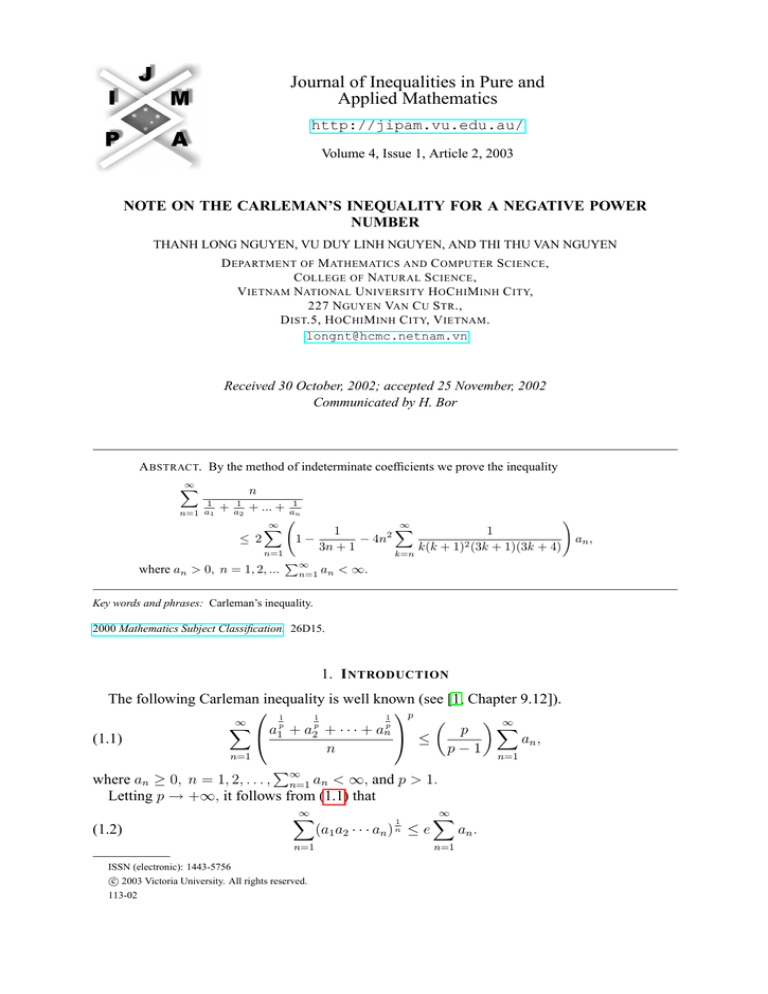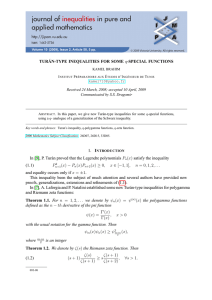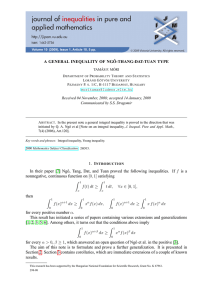
Journal of Inequalities in Pure and
Applied Mathematics
http://jipam.vu.edu.au/
Volume 4, Issue 1, Article 2, 2003
NOTE ON THE CARLEMAN’S INEQUALITY FOR A NEGATIVE POWER
NUMBER
THANH LONG NGUYEN, VU DUY LINH NGUYEN, AND THI THU VAN NGUYEN
D EPARTMENT OF M ATHEMATICS AND C OMPUTER S CIENCE ,
C OLLEGE OF NATURAL S CIENCE ,
V IETNAM NATIONAL U NIVERSITY H O C HI M INH C ITY,
227 N GUYEN VAN C U S TR .,
D IST.5, H O C HI M INH C ITY, V IETNAM .
longnt@hcmc.netnam.vn
Received 30 October, 2002; accepted 25 November, 2002
Communicated by H. Bor
A BSTRACT. By the method of indeterminate coefficients we prove the inequality
∞
X
1
n=1 a1
+
1
a2
n
+ ... +
1
an
∞
X
∞
X
1
1
≤ 2
1−
− 4n2
2 (3k + 1)(3k + 4)
3n
+
1
k(k
+
1)
n=1
k=n
P∞
where an > 0, n = 1, 2, ... n=1 an < ∞.
Key words and phrases: Carleman’s inequality.
2000 Mathematics Subject Classification. 26D15.
1. I NTRODUCTION
The following Carleman inequality is well known (see [1, Chapter 9.12]).
1
p
1
1
X
∞
∞
p
p
p
X
a1 + a2 + · · · + an
p
(1.1)
≤
an ,
n
p − 1 n=1
n=1
P
where an ≥ 0, n = 1, 2, . . . , ∞
n=1 an < ∞, and p > 1.
Letting p → +∞, it follows from (1.1) that
∞
∞
X
X
1
(1.2)
(a1 a2 · · · an ) n ≤ e
an .
n=1
ISSN (electronic): 1443-5756
c 2003 Victoria University. All rights reserved.
113-02
n=1
!
an ,
2
T HANH L ONG N GUYEN , V U D UY L INH N GUYEN ,
AND
T HI T HU VAN N GUYEN
In practice, the inequality (1.2) is strict; i.e.,
∞
∞
X
X
1
(1.3)
(a1 a2 · · · an ) n < e
an ,
n=1
n=1
P∞
if an ≥ 0, n = 1, 2, . . . , 0 < n=1 an < ∞.
The constant e is sharp in the sense that it cannot be replaced by a smaller one.
Recently, the inequality (1.3) has also been improved by many authors, for example: Yang
Bicheng and L. Debnath [2] with
∞
∞ X
X
1
1
(1.4)
(a1 a2 · · · an ) n < e
1−
an ,
2n
+
2
n=1
n=1
in [3] by Yan Ping and Sun Guozheng with
∞
∞ X
X
1
n
1+
(1.5)
(a1 a2 . . . an ) < e
n=1
n=1
and in [4] by X. Yang with
∞
∞ X
X
1
(1.6)
(a1 a2 . . . an ) n < e
1−
n=1
n=1
1
n + 1/5
−1/2
an ,
1
1
1
−
−
2(n + 1) 24(n + 1)2 48(n + 1)3
an ,
and
(1.7)
∞
X
1
(a1 a2 . . . an ) n < e
n=1
∞
X
n=1
1−
6
X
k=1
bk
(n + 1)k
!
an ,
where
1
1
73
11
1945
1
b1 = , b 2 = , b 3 = , b 4 =
, b5 =
, b6 =
,
2
24
48
5760
1280
580608
∞
X
an ≥ 0, n = 1, 2, . . . , 0 <
an < ∞.
n=1
We rewrite the inequality (1.1) with r = p1 as follows
1/r
∞ r
∞
X
X
a1 + ar2 + · · · + arn
(1.8)
≤ (1 − r)−1/r
an ,
n
n=1
n=1
P∞
where an ≥ 0, n = 1, 2, . . . , n=1 an < ∞ and 0 < r < 1.
In [5], we have improved Carleman’s inequality (1.8) for a negative power number r < 0 as
follows
∞
−1/r P
(1
−
r)
an , if − 1 ≤ r < 1, r 6= 0,
∞ r
r
r 1/r
X
n=1
a1 + a2 + · · · + an
(1.9)
≤
n
∞
n=1
r 2(r−1)/r P a , if r < −1,
r−1
n
n=1
P
where an > 0, n = 1, 2, . . . , ∞
n=1 an < ∞.
In the case of r = −1, we obtain from (1.9) the inequality
∞
∞
X
X
n
(1.10)
an ,
1
1
1 ≤ 2
+
+
·
·
·
+
a
a
a
n
n=1 1
n=1
2
P∞
where an > 0, n = 1, 2, . . . , n=1 an < ∞.
J. Inequal. Pure and Appl. Math., 4(1) Art. 2, 2003
http://jipam.vu.edu.au/
N OTE ON THE C ARLEMAN ’ S I NEQUALITY
FOR A
N EGATIVE P OWER N UMBER
3
2. M AIN R ESULT
In this paper, we shall prove the following theorem.
P
Theorem 2.1. Let an > 0, n = 1, 2, . . . , and ∞
n=1 an < ∞. Then we have
(2.1)
∞
X
1
n=1 a1
+
1
a2
n
+ ··· +
1
an
≤2
∞
X
n=1
∞
X
1
1
2
1−
− 4n
2
3n + 1
k(k + 1) (3k + 1)(3k + 4)
k=n
!
an .
Remark 2.2. From the inequality (2.1), we obtain the following inequalities:
(2.2)
∞
X
1
n=1 a1
+
1
a2
n
+ ··· +
<2
1
an
n=1
∞
X
(2.3)
1
n=1 a1
+
∞ X
1
a2
n
+ ··· +
1
4n
1−
−
2
3n + 1 (n + 1) (3n + 1)(3n + 4)
1
an
<2
∞ X
n=1
1
1−
3n + 1
an ,
an ,
and
∞
X
(2.4)
1
n=1 a1
+
1
a2
n
+ ··· +
1
an
<2
∞
X
an .
n=1
Indeed, we note that the inequalities (2.2), (2.3), (2.4) are implied from (2.1), because
∞
X
1
1
2
− 4n
1−
2
3n + 1
k(k + 1) (3k + 1)(3k + 4)
k=n
(2.5)
1
4n
−
2
3n + 1 (n + 1) (3n + 1)(3n + 4)
1
<1−
< 1.
3n + 1
<1−
Hence, we obtain from (2.1), (2.5) that
(2.6)
∞
X
1
n=1 a1
+
1
a2
n
+ ··· +
≤2
=2
∞
X
n=1
∞ X
1
an
∞
X
1
1
2
1−
− 4n
2
3n + 1
k(k + 1) (3k + 1)(3k + 4)
k=n
!
an
1
4n
−
2
3n + 1 (n + 1) (3n + 1)(3n + 4)
n=1
!
∞
X
1
2
− 4n
an
k(k + 1)2 (3k + 1)(3k + 4)
k=n+1
1−
J. Inequal. Pure and Appl. Math., 4(1) Art. 2, 2003
http://jipam.vu.edu.au/
4
T HANH L ONG N GUYEN , V U D UY L INH N GUYEN ,
AND
T HI T HU VAN N GUYEN
∞ X
1
4n
=2
−
an
1−
3n + 1 (n + 1)2 (3n + 1)(3n + 4)
n=1
!
∞
∞
X
X
1
−8
n 2 an
2
k(k + 1) (3k + 1)(3k + 4)
n=1
k=n+1
∞
X
1
4n
<2
1−
−
an
3n + 1 (n + 1)2 (3n + 1)(3n + 4)
n=1
∞ X
1
< 2
1−
an
3n
+
1
n=1
<2
∞
X
an .
n=1
To prove Theorem 2.1, we first prove the following lemma.
Lemma 2.3. We have
1
a1 b21 + a2 b22 + · · · + an b2n
(2.7)
≤
1
2 ,
1
1
+
+
·
·
·
+
(b
+
b
+
·
·
·
+
b
)
1
2
n
a1
a2
an
where ak > 0, bk > 0, ∀k = 1, 2, . . . , n.
Proof. This is a simple application of the Cauchy-Schwartz inequality
2
1 √
1 √
1 √
2
(2.8)
an b n
a2 b 2 + · · · + √
a1 b 1 + √
(b1 + b2 + · · · + bn ) ≤ √
an
a2
a1
1
1
1
≤
+
+ ··· +
a1 b21 + a2 b22 + · · · + an b2n .
a1 a2
an
Proof of Theorem 2.1. We prove the theorem by the method of indeterminate coefficients.
Consider b1 , b2 , . . . to be the positive indeterminate coefficients. Let N = 1, 2, . . . Put
Ck =
(2.9)
N
X
nb2k
, 1 ≤ k ≤ N.
(b + b2 + · · · + bn )2
n=k 1
Applying Lemma 2.3, we obtain
(2.10)
N
X
1
n=1 a1
+
1
a2
n
+ ··· +
1
an
≤
N X
n
X
n=1 k=1
=
N X
N
X
k=1 n=k
=
N
X
nak b2k
(b1 + b2 + · · · + bn )2
nak b2k
(b1 + b2 + · · · + bn )2
Ck ak .
k=1
Choosing bk = k, k = 1, 2, . . . , we have from (2.9) that
(2.11)
Ck =
N
X
n=k
N
X
nk 2
1
2
.
2 = 4k
(1 + 2 + · · · + n)
n (n + 1)2
n=k
J. Inequal. Pure and Appl. Math., 4(1) Art. 2, 2003
http://jipam.vu.edu.au/
N OTE ON THE C ARLEMAN ’ S I NEQUALITY
FOR A
N EGATIVE P OWER N UMBER
5
On the other hand, we have the equality
(2.12)
2n2
1
1
1
−
−
2
2
2
+ 3 n 2(n + 1) + 3 (n + 1) n (n + 1)2
2
=
> 0, for all n = 1, 2, . . .
2
n (n + 1) (3n + 1)(3n + 4)
Hence, it follows from (2.11) that
(2.13)
N
X
n=k
1
n (n + 1)2
N
X
1
1
2
= 2 2 −
−
2
2
2
2k + 3 k 2(N + 1) + 3 (N + 1) n=k n (n + 1) (3n + 1)(3n + 4)
N
X
1
2
≤ 2 2 −
, 1 ≤ k ≤ N.
2
2k + 3 k n=k n (n + 1) (3n + 1)(3n + 4)
Hence, we obtain from (2.10), (2.13) that
(2.14)
Ck = 4k
2
N
X
n=k
(2.15)
N
X
1
n=1 a1
+
≤
1
a2
N
X
N
X
2
1
1
2
− 8k
.
2 ≤ 2−
2
3k + 1
n (n + 1)
n
(n
+
1)
(3n
+
1)(3n
+
4)
n=k
n
+ ··· +
1
an
Ck ak
k=1
!
N
X
2
1
≤
2−
− 8k 2
ak
3k
+
1
n (n + 1)2 (3n + 1)(3n + 4)
k=1
n=k
!
N N
N
X
X
X
2
1
≤
2−
ak − 8
k 2 ak
2
3k
+
1
n (n + 1) (3n + 1)(3n + 4)
k=1
k=1
n=k
!
N
N
n
X
X
X
2
k 2 ak
=
2−
ak − 8
3k + 1
n (n + 1)2 (3n + 1)(3n + 4)
n=1
k=1
k=1
N N
X
X
2
=
2−
ak − 8
βn .
3k
+
1
n=1
k=1
N
X
where
Pn
(2.16)
k 2 ak
βn =
.
n (n + 1)2 (3n + 1)(3n + 4)
J. Inequal. Pure and Appl. Math., 4(1) Art. 2, 2003
k=1
http://jipam.vu.edu.au/
6
T HANH L ONG N GUYEN , V U D UY L INH N GUYEN ,
AND
T HI T HU VAN N GUYEN
We have
0 < βn
(2.17)
Pn
k 2 ak
=
n (n + 1)2 (3n + 1)(3n + 4)
P
n2 nk=1 ak
≤
9n5
n
∞
1 X
1 X
ak ∼ 3
ak , as n → +∞.
= 3
9n k=1
9n k=1
k=1
Hence, the series
(2.18)
∞
X
P∞
n=1
βn converges. Letting N → +∞ in (2.15), we obtain
n
1
n=1 a1
+ a12 +
∞ X
≤
k=1
∞ X
··· +
1
an
2
2−
3k + 1
2
2−
3k + 1
2
2−
3k + 1
ak − 8
∞
X
βn
n=1
∞
n
X
X
k 2 ak
n (n + 1)2 (3n + 1)(3n + 4)
!
1
=
ak − 8
2
n (n + 1) (3n + 1)(3n + 4)
k=1
k=1
n=k
!
∞
∞
X
X
1
1
=2
1−
− 4k 2
ak .
3k
+
1
n (n + 1)2 (3n + 1)(3n + 4)
k=1
n=k
!
=
k=1
∞ X
ak − 8
n=1
∞
X
k=1
∞
X
k 2 ak
The proof of Theorem 2.1 is complete.
R EFERENCES
[1] G.H. HARDY, J.E. LITTLEWOOD
don,1952.
AND
G. POLYA, Inequalities, Cambridge Univ. Press, Lon-
[2] BICHENG YANG AND L. DEBNATH, Some inequalities involving the constant e and an application
to Carleman’s inequality, J. Math. Anal. Appl., 223 (1998), 347–353.
[3] YAN PING AND GUOZHENG SUN, A strengthened Carleman’s inequality, J. Math. Anal. Appl.,
240 (1999), 290–293.
[4] XIAOJING YANG, On Carleman’s inequality, J. Math. Anal. Appl., 253 (2001), 691–694.
[5] THANH LONG NGUYEN AND VU DUY LINH NGUYEN, The Carleman’s inequality for a negative power number, J. Math. Anal. Appl., 259 (2001), 219–225.
J. Inequal. Pure and Appl. Math., 4(1) Art. 2, 2003
http://jipam.vu.edu.au/












